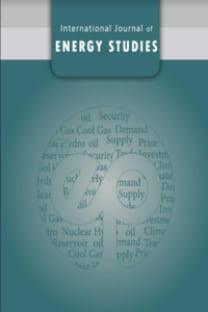Model of the combi boiler appliance in TRNSYS for domestic hot water circuit: Experimental and numerical validations of economic mode simulations
Model of the combi boiler appliance in TRNSYS for domestic hot water circuit: Experimental and numerical validations of economic mode simulations
Combi boilers, Domestic hot water (DHW) circuit, TRNSYS model, One-dimensional (1D) modelling,
___
- [1] Atmaca AU, Erek A, Altay HM. Investigation of transient behaviour of combi boiler type appliances for domestic hot water. Applied Thermal Engineering 2015; 82: 129-140.
- [2] Atmaca AU, Erek A, Altay HM. Comparison of two numerical approaches to the domestic hot water circuit in a combi boiler appliance. Energy and Buildings 2016; 127: 1043-1056.
- [3] BS EN 13203-1:2006. Gas-fired domestic appliances producing hot water- appliances not exceeding 70 kW heat input and 300 L water storage capacity - part 1: assessment of performance of hot water deliveries. 2006.
- [4] Boait PJ, Dixon D, Fan D, Stafford A. Production efficiency of hot water for domestic use. Energy and Buildings 2012; 54: 160-168.
- [5] Pärisch P, van der Veer N, Kirchner M, Giovannetti F, Lampe C. Comfort assessment of tankless water heaters: review and suggestions. International Energy Agency Solar Heating & Cooling Programme (IEA SHC) International Conference on Solar Heating and Cooling for Buildings and Industry, Santiago, Chile, 2019.
- [6] Pomianowski MZ, Johra H, Marszal-Pomianowska A, Zhang C. Sustainable and energy-efficient domestic hot water systems: a review. Renewable and Sustainable Energy Reviews 2020; 128: 109900.
- [7] Haissig CM, Woessner M. An adaptive fuzzy algorithm for domestic hot water temperature control of a combi-boiler. HVAC&R Research 2000; 6(2): 117-134.
- [8] Ucar M, Arslan, O. Assessment of improvement potential of a condensed combi boiler via advanced exergy analysis. Thermal Science and Engineering Progress 2021; 23: 100853.
- [9] Fridlyand A, Guada AB, Kingston T, Glanville P. Modeling modern, residential, combined space and water heating systems using EnergyPlus. ASHRAE Transactions 2021; 127: 135-142.
- [10] Quintã AF, Ferreira JAF, Ramos A, Martins NAD, Costa VAF. Simulation models for tankless gas water heaters. Applied Thermal Engineering 2019; 148: 944–952.
- [11] Jordan U, Vajen K. Influence of the dhw load profile on the fractional energy savings: a case study of a solar combi-system with TRNSYS simulations. Solar Energy 2001; 69: 197-208.
- [12] Andrés AC, López JMC. TRNSYS model of a thermosiphon solar domestic water heater with a horizontal store and mantle heat exchanger. Solar Energy 2002; 72(2): 89-98.
- [13] Nordlander SG, Persson TG. Evaluation and computer modelling of wood pellet stoves with liquid heat exchanger. International Solar Energy Society (ISES) World Conference, Gothenburg, Sweden, 2003.
- [14] Persson T, Fiedler F, Nordlander S, Bales C, Paavilainen J. Validation of a dynamic model for wood pellet boilers and stoves. Applied Energy 2009; 86(5): 645-656.
- [15] Bourke G, Bansal P. New test method for gas boosters with domestic solar water heaters. Solar Energy 2012; 86(1): 78-86.
- [16] Persson T, Wiertzema H, Win KM, Bales C. Modelling of dynamics and stratification effects in pellet boilers. Renewable Energy, 2019; 134: 769-782.
- [17] Antoniadis CN, Martinopoulos G. Optimization of a building integrated solar thermal system with seasonal storage using TRNSYS. Renewable Energy 2019; 137: 56-66.
- [18] Villa-Arrieta M, Sumper A. A model for an economic evaluation of energy systems using TRNSYS. Applied Energy 2018; 215: 765–777.
- [19] Incropera FP, Dewitt DP, Bergman TL, Lavine AS. Fundamentals of heat and mass transfer (6th edition). John Wiley & Sons, Inc, USA, 2007.
- Yayın Aralığı: Yılda 4 Sayı
- Başlangıç: 2016
- Yayıncı: Türkiye Enerji Stratejileri ve Politikaları Araştırma Merkezi (TESPAM)
Small hydropower development in Turkey: An overview of 2021
Ensuring energy balance for sudden demand changes in smart grids
Ahmet KARYEYEN, Nurettin ÇETİNKAYA
Effect of material on efficiency in alternators used in wind energy
Simulation of a PV module at different set-up and operating conditions to give I-V and P-V curves
Anas BALA, Jamilu Ya'u MUHAMMAD, Kadawa Ibrahim ALİ, Richard Balthia MSHELLİA
Okan GÖK, Ayşe Uğurcan ATMACA, Hürrem Murat ALTAY, Aytunç EREK
A comprehensive survey of the urban building energy modeling (UBEM) process and approaches
